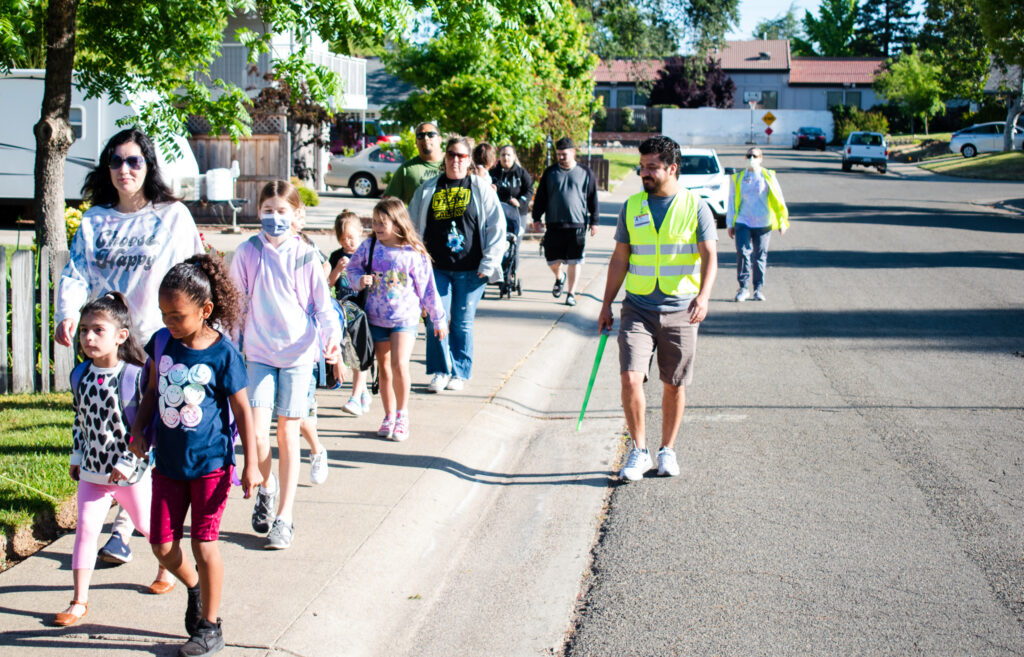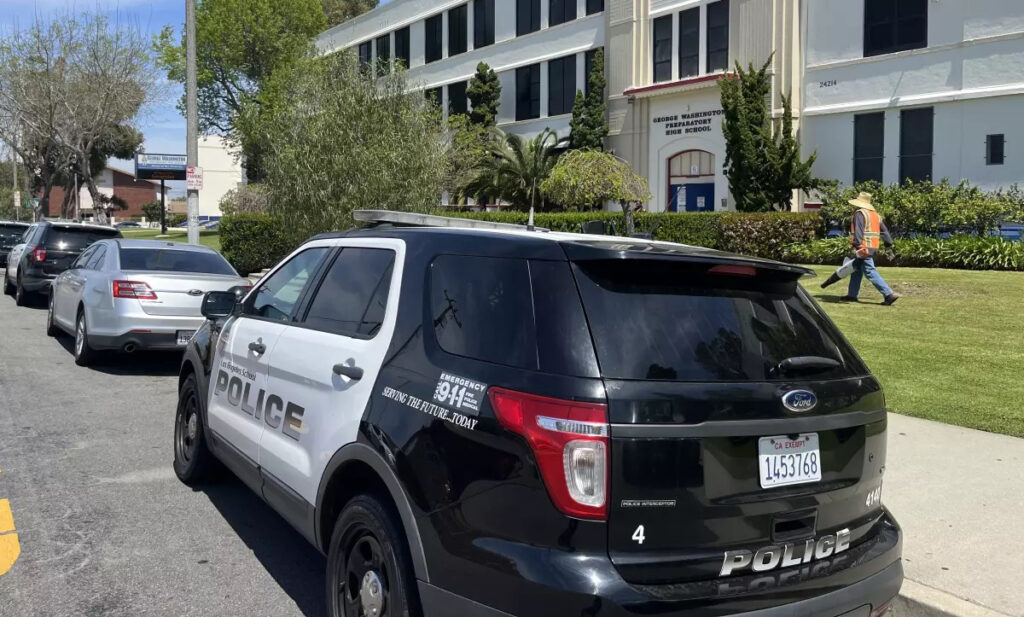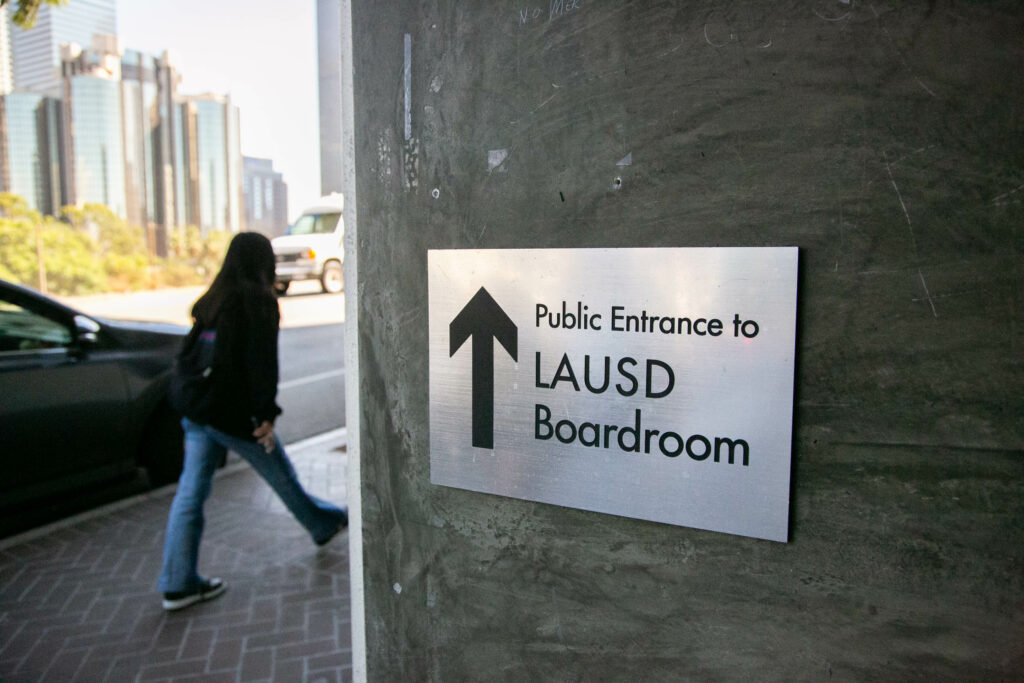
San Juan Unified in Sacramento County implemented the Safe Routes to School initiative and other measures to address pedestrian safety, including the Charles Peck Elementary School “May the 4th be with you!” Walk to School Day.
Credit: Courtesy of Civic Thread
This story was updated to reflect Clovis Unified’s 2022-23 accident data that was provided after the story’s publication.
As students waited for a bus in front of Roosevelt High School last September, a vehicle crashed into the bus stop, injuring 11 of them. The next day, a mom was walking her four children to school when a driver ran a traffic light, hitting the mom and dragging one of her children. They were using the crosswalk.
These incidents represent a few of the many accidents involving students or pedestrians being hit by vehicles on or near Fresno Unified campuses between August and December.
“Those are the ones that made the news,” said Amy Idsvoog, executive officer for health services, safety and emergency response for Fresno Unified School District.
Many more incidents never made the news but can still be traumatizing for students and families, causing them to live in fear over their safety when getting to or leaving school.
“We saw a need even last year to try and do something,” Idsvoog said.
Fresno Unified district leaders, Idsvoog said, first noticed an uptick in the number of students being hit by cars in the 2022-23 school year when there were 17 incidents, including a death in October 2022. In the aftermath of the student’s death, board member Andy Levine acknowledged “the reality that our students are not safe when they step right off of campus,” and that the district needed to “make sure that never happens ever again.”
Despite the district’s efforts to improve pedestrian safety, Fresno Unified is recording double-digit numbers of incidents for the second consecutive school year — nearing 20 incidents this school year with about six months of school remaining.
Fresno Unified, the state’s third-largest school district, with about 70,000 students, is trying to curb the frequency of accidents involving students being hit by vehicles by teaching students about pedestrian safety, displaying banners and materials on campuses and educating the wider community on the importance of the topic.
“It just seems to be something that is not stopping,” Fresno Unified Superintendent Bob Nelson said in late September after a student on her way to school was hit by a vehicle. “It just can’t continue to happen to our kids. Our kids deserve to be safe as they travel to and from school.”
Now the school district is working to implement the Safe Routes to School initiative to address pedestrian safety.
Fresno-area districts, organizations launched a campaign last school year
Fresno Unified’s 17 vehicles vs. student/pedestrian incidents in the 2022-23 school year was up from seven in 2018-19, nine in 2019-20 and four in 2020-21. The district had zero reported incidents in 2021-22, when all students returned to in-person learning following the pandemic.
But there’s not a sole explanation for the increased number of incidents, Idsvoog said.
She explained that among many factors, possible causes include pedestrians not using crosswalks or doing so incorrectly, drivers not paying attention to a stop sign or traffic light in a school zone, as well as parents dropping students off in the middle of the street, rather than in a drop-off zone. The district has also seen a rising number of cases involving student drivers, including four this school year.
“No one can exactly come up with why yet,” she said.
Idsvoog said she learned from the Council of the Great City Schools, a coalition of 78 of the nation’s largest urban public school systems, that school districts across the nation have not found the answer either.
Nationally, some school districts have tried different methods to address pedestrian safety, including buying $20,000 speed monitoring displays, Idsvoog said. (Fresno Unified has at least two dozen schools with speed monitors requiring a battery replacement.) As of Jan. 1, thanks to new legislation across the state, six California cities will install automated speed cameras in school zones.
“I think everyone is trying to address the same problem,” Idsvoog said. “I don’t think there’s this magic ticket yet that says, ‘This is what you do.’”
In April 2023, Fresno Unified, the Fresno County superintendent of schools, Central Unified, Clovis Unified, Sanger Unified, the Fresno Police Department and the city of Fresno launched Street Smart, a joint pedestrian safety campaign.
“They all wanted to get the message out and, hopefully, have a stronger impact on the community,” Idsvoog said. “But we know there’s more that has to be done.”
‘It’s not enough’
Despite the multi-agency campaign and other efforts, the number of incidents involving students or pedestrians being hit by vehicles on or near campus has remained stagnant in some districts.
Central Unified, a district in Fresno that participated in the Street Smart campaign, reported one incident this school year of someone being hit while crossing the street near a school — a number that has not changed from the previous school year.
The district has continually invested in crossing guards, monitored signage and crosswalk painting needs and advocated for infrastructure improvements, including a High-intensity Activated crossWalK (HAWK) grant near Herndon-Barstow Elementary, a four-way stop near Teague Elementary and additional sidewalks, according to a district spokesperson.
So far this school year, between August and Jan. 9, Clovis Unified has recorded 18 incidents of a vehicle striking a pedestrian or bicyclist in contrast to eight incidents last school year. No injuries were reported either year, said district spokesperson Kelly Avants.
Still, the district continues to focus on pedestrian safety, Avants said, citing crossing guards at busy intersections, reminders to families to follow traffic laws and education of students and the community.
Fresno Unified also “isn’t there yet,” Idsvoog said about numbers continuing to rise year after year. As of Friday, the number of students hit as they traveled to or from school stood at 17 — already matching the total at the end of the last school year.
In the spring 2023 semester, Fresno Unified launched an age-appropriate pedestrian safety curriculum, which is available again this school year. The school district even sought additional volunteer crossing guards and conducted community outreach about pedestrian safety.
Idsvoog said that Fresno Unified’s education and outreach efforts to address pedestrian safety are not “enough to resolve the problem.”
“Everything we’re intending to do is still not enough,” she said. “It’s not enough because we’re not seeing a decrease in incidents.”
Safe Routes to School initiative
The Safe Routes to School initiative pilot is assessing 15 schools in Fresno Unified, representing the seven high school regions:
- Bullard High
- Hoover High
- McLane High
- Roosevelt High
- Duncan High
- Cooper Middle
- Computech Middle
- Kings Canyon Middle
- Scandinavian Middle
- Tioga Middle
- Wawona K-8
- Herrera Elementary
- Lincoln Elementary
- Roeding Elementary
- Vang Pao Elementary
Also a part of the Safe Routes to School initiative are community meetings.
The next meetings will be at the Roosevelt High School cafeteria on Jan. 18 and at the Bullard High cafeteria on Jan. 22. The meetings run from 5:30 to 6:30 pm.
That’s why the district started the Safe Routes to School initiative this school year.
Through a pilot at some of the district’s schools, Toole Design — a company that assesses city infrastructure, develops pedestrian safety programs and improves school arrival and dismissal — is assessing students’ routes to school.
The assessments will help Fresno Unified find school and district practices to create safe routes to school for all students, whether they are using a scooter, walking, biking or being dropped off, Idsvoog said.
Identifying the routes that students use to travel to and from school each day will allow the district to evaluate whether changes should be made.
In choosing the piloted campuses, the district considered whether students had been hit there, whether bus accidents had occurred and the proximity to another school. Idsvoog said the district hopes to assess 15 more schools next year through grant funding.
The assessments will also determine how the city might be able to help the district.
For example, Herrera Elementary, Fresno Unified’s newest school, between Storey Elementary and Terronez Middle, has no curbs or sidewalks on one side of the school.
Besides creating safe routes for students, the assessments can lead to district events continuing the community’s education on the importance of pedestrian safety.
Such events, Idsvoog said, could help reduce incidents and extend dialogue and awareness.
What FUSD can learn from other districts that implemented initiative
San Juan Unified, a 40,000-student district with 64 K-12 schools, implemented the Safe Routes to School initiative to address pedestrian safety. Located in Sacramento County, San Juan Unified comprises incorporated cities as well as communities such as Citrus Heights and Orangevale.
In partnership with the nonprofit organization Civic Thread, the district developed classroom presentations, demonstrations and other activities on pedestrian safety, according to Natalee Dyudyuk, community safety specialist and Safe Routes to School coordinator in San Juan Unified.
The demonstrations encompass a pretend intersection with stop signs, traffic lights and crosswalks; student volunteers act out what happens when “safe crossing skills” learned in the presentation are used or not, Dyudyuk said.
Following the demonstration, groups visit a crosswalk near the school to practice their skills, she said.
“As I always like to mention to the students, the drivers on the street are not paid actors,” Dyudyuk said about the effectiveness of the real-world scenario. “They are folks who are driving throughout the community, trying to get from point A to point B. It’s a great way to practice because you don’t ever quite know how those drivers are going to react to our presence there.”
For its educational activities, the school district hosts bicycle rodeos, helmet giveaways and walk- or bike-to-school days, with students forming a “walking bus” or a “bike train,” Dyudyuk said.
“Parents get really excited about that,” she said.
According to Raj Rai, San Juan Unified district communication director, pedestrian safety efforts date back to at least 2010. District investments have grown from one liaison working with law enforcement to a safe schools department with eight community safety specialists.
In her role since 2021, Dyudyuk works with schools to evaluate student pickup and dropoff and to create checklists and visuals for families to use — education and outreach that continues beyond the initial Safe Routes to School assessments.
Universities implement education, enforcement
Just as K-12 school districts locally and nationally have worked to address pedestrian safety, so have higher education institutions.
Each semester, Cal Poly Humboldt in Arcata displays signs “warning and reminding” pedestrians and bicyclists to stop at intersections and others to obey traffic laws, said Peter Cress, a lieutenant with the university’s police department.
When education and warnings don’t work, the university’s police can turn to enforcement: ticketing drivers. Crediting the college’s approach of using education and enforcement, Cress said that the 5,700-student Cal Poly Humboldt averages one vehicle-pedestrian incident causing significant injury annually. In September, a student was hit while crossing the street.
Enforcement — or the threat of enforcement — is the only proven way to change motorists’ behavior, Cress said. So, even though education is imperative to what schools do to address pedestrian safety, Cress encourages K-12 districts to implement enforcement through citations, possibly by partnering with local law enforcement.
That kind of enforcement isn’t an easy feat for K-12 school systems.
Idsvoog said that while the Fresno Police Department has worked to place more patrol officers at schools during student arrival and dismissal, police cannot be at Fresno Unified’s 107 schools every day at the same time while patrolling other parts of the city.
One way to fill the void and help with enforcement, Idsvoog said, is using volunteer crossing guards. With more crossing guards, Fresno Unified can strengthen pedestrian safety, she said.
But there’s never enough crossing guards, Idsvoog said, and the district usually relies on teachers for that role at schools’ multiple crosswalks used by students.
Kimberly Armstrong, second grade teacher at Kirk Elementary, became a volunteer crossing guard out of concern for her students. As a crossing guard, she said she still witnesses people disregarding traffic laws.
“There’s really no consequences for them to do any better,” Armstrong said during the Dec. 12 Safe Routes to School community meeting at Computech Middle School. She implored district leaders to find a way to add police at school arrival and dismissal, even if they have to rotate between schools or regions.
Fresno Unified school officials can report areas where high numbers of pedestrian safety concerns are occurring to police, Idsvoog said, but problems exist at each of the district’s more than 100 campuses.
“Having a police officer there is not just the answer,” Idsvoog said. “There is no quick resolution. There’s got to be a bigger plan: more education, more messaging to parents, yes, consequences.”
‘Everyone’s responsibility’
While law enforcement can define social expectations and attitudes toward pedestrian safety on a higher ed campus, the school community of parents, school staff and community members can set the standard in a K-12 environment, Lt. Cress said.
When parents and community members witness or learn about pedestrian safety concerns, Cress said, they must have difficult conversations with each other, which will lead to “conversation after conversation after conversation.”
“Those types of informal conversations generate a community attitude,” he said.
Ensuring pedestrian safety
“There’s so many things that we all can do,” Idsvoog said, including:
- Adhering to speed limits, crosswalks and traffics signs, including the stop signs that are deployed from school buses
- Being aware of one’s surroundings
- Having conversations with students
District leaders and school staff in the Fresno, Clovis, Central and San Juan districts agreed that student and pedestrian safety is a community effort that requires everyone’s effort — not just parents and students.
“Pedestrian safety is everyone’s responsibility,” Idsvoog said. “And it’s going to take parents, community members and even students to really make a difference.”
Armstrong, the teacher and volunteer crossing guard, said she is optimistic about the district’s efforts, but “time is of the essence” to improve pedestrian safety. The importance of students arriving at and leaving campus safely is often overlooked and missing from the conversation about school safety, she said.
“We can’t just worry about kids and their safety once they’re inside of our school buildings,” Armstrong said. “We have to ensure their safety getting to and from. It’s just as important.”
















